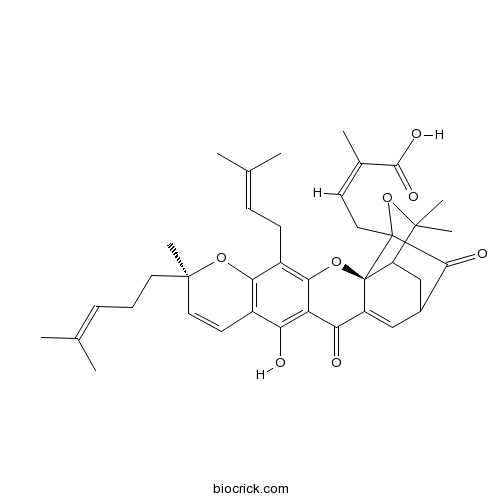Garcinia hanburyi
Garcinia hanburyi
1. The products in our compound library are selected from thousands of unique natural products; 2. It has the characteristics of diverse structure, diverse sources and wide coverage of activities; 3. Provide information on the activity of products from major journals, patents and research reports around the world, providing theoretical direction and research basis for further research and screening; 4. Free combination according to the type, source, target and disease of natural product; 5. The compound powder is placed in a covered tube and then discharged into a 10 x 10 cryostat; 6. Transport in ice pack or dry ice pack. Please store it at -20 °C as soon as possible after receiving the product, and use it as soon as possible after opening.
Natural products/compounds from Garcinia hanburyi
- Cat.No. Product Name CAS Number COA
-
BCN2318
Gambogic acid2752-65-0
Instructions

-
BCN2321
Neogambogic acid93772-31-7
Instructions

Synergistic Effect of Forbesione From Garcinia hanburyi in Combination with 5-Fluorouracil on Cholangiocarcinoma[Pubmed: 29286229]
Chemotherapy for advanced cholangiocarcinoma (CCA) is largely ineffective; thus innovative combinations of chemotherapeutic agents and natural compounds represent a promising strategy. This study aimed to investigate the synergistic effects of forbesione combined with 5-fluorouracil (5-FU) in hamster cholangiocarcinoma (Ham-1) cells both in vitro and in vivo. The anti-tumor effects of 5-FU combined with forbesione in vitro were determined using the Sulforhodamine B (SRB) assay and the effects in vivo were assessed in transplanted Ham-1 allograph models. Using ethidium bromide/acridine orange (EB/AO) staining, the morphological changes of apoptotic cells was investigated. The expressions of apoptosis-related molecules after combined treatment with forbesione and 5-FU were determined using real-time RT-PCR and western blot analysis. Forbesione or 5-FU alone inhibited proliferation of Ham-1 cells in a dose-dependent manner and their combination showed a synergistic proliferation inhibitory effect in vitro. In vivo studies, forbesione in combination with 5-FU exhibited greater inhibition of the tumor in the hamster model compared with treatment using either drug alone. Forbesione combined with 5-FU exerted stronger apoptotic induction in Ham-1 cells than did single drug treatment. The combination of drugs strongly suppressed the expression of B-cell lymphoma 2 (Bcl-2) and procaspase-3 while enhancing the expression of p53, Bcl-2-associated X protein (Bax), apoptotic protease activating factor-1 (Apaf-1), caspase-9 and caspase-3, compared with single drug treatments. These results explained the decreased expression of cytokeratin 19 (CK19) positive cells and proliferation cell nuclear antigen (PCNA) positive cells in Ham-1 cell tumor tissues of the treated hamsters. There was no apparent systemic toxicity observed in the treated animals compared with the control groups. Forbesione combined with 5-FU strongly induced apoptosis in Ham-1 cells. The growth inhibitory effect of combined treatment using these two drugs was much greater than treatment with either drug alone, both in vitro and in vivo.
Therapeutic potential of gambogic acid, a caged xanthone, to target cancer.[Pubmed: 29246645]
Natural compounds have enormous biological and clinical activity against dreadful diseases such as cancer, as well as cardiovascular and neurodegenerative disorders. In spite of the widespread research carried out in the field of cancer therapeutics, cancer is one of the most prevalent diseases with no perfect treatment till date. Adverse side effects and the development of chemoresistance are the imperative limiting factors associated with conventional chemotherapeutics. For this reason, there is an urgent need to find compounds that are highly safe and efficacious for the prevention and treatment of cancer. Gambogic acid (GA) is a xanthone structure extracted from the dry, brownish gamboge resin secreted from the Garcinia hanburyi tree in Southeast Asia and has inherent anti-cancer properties. In this review, the molecular mechanisms underlying the targets of GA that are liable for its effective anti-cancer activity are discussed that reveal the potential of GA as a pertinent candidate that can be appropriately developed and designed into a capable anti-cancer drug.
Isogambogenic Acid Inhibits the Growth of Glioma Through Activation of the AMPK-mTOR Pathway.[Pubmed: 29186708]
Glioma is the most devastating cancer in the brain and has a poor prognosis in adults. Therefore, there is a critical need for novel therapeutic strategies for the management of glioma patients. Isogambogenic acid, an active compound extracted from the Chinese herb Garcinia hanburyi, induces autophagic cell death.
Gambogic Acid and Its Role in Chronic Diseases.[Pubmed: 27671824]
Kokum, a spice derived from the fruit of the Garcinia hanburyi tree, is traditionally used in Ayurvedic medicines to facilitate digestion and to treat sores, dermatitis, diarrhoea, dysentery, and ear infection. One of the major active components of kokum is gambogic acid, also known as guttic acid, guttatic acid, beta-guttilactone, and beta-guttiferin. Gambogic acid's anti-proliferative, anti-bacterial; antioxidant and anti-inflammatory effects result from its modulation of numerous cell-signaling intermediates. This chapter discusses the sources, chemical components, mechanism of action, and disease targets of the kokum spice.
Molecular targets of gambogic acid in cancer: recent trends and advancements.[Pubmed: 27448303]
Natural compounds have been known as biosafety agents for their significant clinical and biological activity against dreadful diseases, including cancer, cardiovascular, and neurodegenerative disorders. Gambogic acid (GA), a naturally occurring xanthone-based moiety, reported from Garcinia hanburyi tree, is known to perform numerous intracellular and extracellular actions, including programmed cell death, autophagy, cell cycle arrest, antiangiogenesis, antimetastatic, and anti-inflammatory activities. In addition, GA-based synergistic approaches have been proven to enhance the healing strength of existing chemotherapeutic agents along with lesser side effects. The present review uncovers the bio-therapeutic potential of gambogic acid along with the possible mechanistic interactions of GA with its recognized cellular targets.


